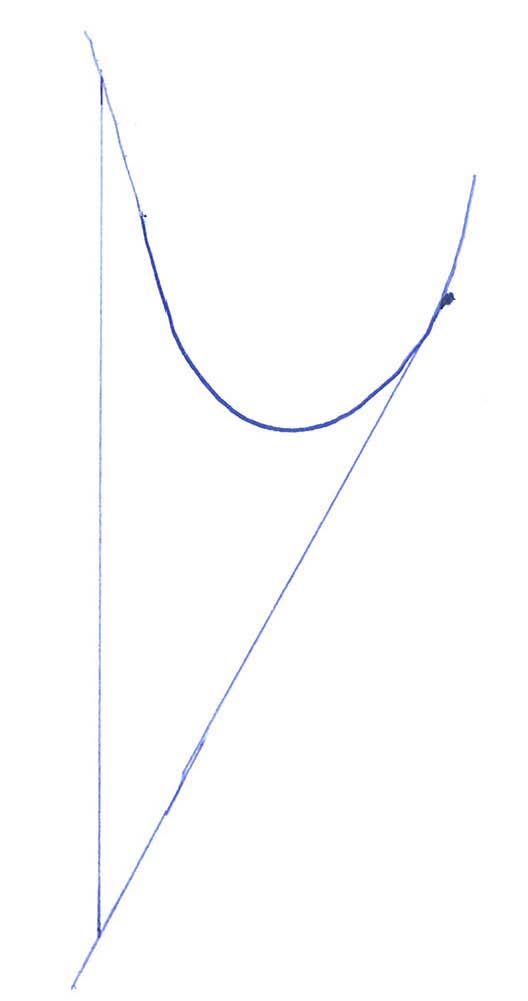http://en.wikipedia.org/wiki/Gradient_descent
http://zh.wikipedia.org/wiki/%E6%9C%80%E9%80%9F%E4%B8%8B%E9%99%8D%E6%B3%95
Gradient descent is based on the observation that if the multivariable function is defined and differentiable in a neighborhood of a point
is defined and differentiable in a neighborhood of a point  , then
, then  decreases fastest if one goes from
decreases fastest if one goes from  in the direction of the negative gradient of
in the direction of the negative gradient of  at
at  ,
, 
為啥步長要變化?Tianyi的解釋很好:如果步長過大,可能使得函數值上升,故要減小步長 (下面這個圖片是在紙上畫好,然后scan的)。
Andrew NG的coursera課程Machine learning的II. Linear Regression with One Variable的Gradient descent Intuition中的解釋很好,比如在下圖在右側的點,則梯度是正數, 是負數,即使當前的a減小
是負數,即使當前的a減小
 例1:Toward the Optimization of Normalized Graph Laplacian(TNN 2011)的Fig. 1. Normalized graph Laplacian learning algorithm是很好的梯度下降法的例子.只要看Fig1,其他不必看。Fig1陶Shuning老師課件 非線性優化第六頁第四個ppt,對應教材P124,關鍵直線搜索策略,應用 非線性優化第四頁第四個ppt,步長加倍或減倍。只要目標減少就到下一個搜索點,并且步長加倍;否則停留在原點,將步長減倍。
例1:Toward the Optimization of Normalized Graph Laplacian(TNN 2011)的Fig. 1. Normalized graph Laplacian learning algorithm是很好的梯度下降法的例子.只要看Fig1,其他不必看。Fig1陶Shuning老師課件 非線性優化第六頁第四個ppt,對應教材P124,關鍵直線搜索策略,應用 非線性優化第四頁第四個ppt,步長加倍或減倍。只要目標減少就到下一個搜索點,并且步長加倍;否則停留在原點,將步長減倍。
例2: Distance Metric Learning for Large Margin Nearest Neighbor Classification(JLMR),目標函數就是公式14,是矩陣M的二次型,展開后就會發現,關于M是線性的,故是凸的。對M求導的結果,附錄公式18和19之間的公式中沒有M
我自己額外的思考:如果是凸函數,對自變量求偏導為0,然后將自變量求出來不就行了嘛,為啥還要梯度下降?上述例二是不行的,因為對M求導后與M無關了。和tianyi討論,正因為求導為0 沒有解析解采用梯度下降,有解析解就結束了
http://zh.wikipedia.org/wiki/%E6%9C%80%E9%80%9F%E4%B8%8B%E9%99%8D%E6%B3%95
Gradient descent is based on the observation that if the multivariable function
 is defined and differentiable in a neighborhood of a point
is defined and differentiable in a neighborhood of a point  , then
, then  decreases fastest if one goes from
decreases fastest if one goes from  in the direction of the negative gradient of
in the direction of the negative gradient of  at
at  ,
, 
為啥步長要變化?Tianyi的解釋很好:如果步長過大,可能使得函數值上升,故要減小步長 (下面這個圖片是在紙上畫好,然后scan的)。
Andrew NG的coursera課程Machine learning的II. Linear Regression with One Variable的Gradient descent Intuition中的解釋很好,比如在下圖在右側的點,則梯度是正數,
 是負數,即使當前的a減小
是負數,即使當前的a減小
例2: Distance Metric Learning for Large Margin Nearest Neighbor Classification(JLMR),目標函數就是公式14,是矩陣M的二次型,展開后就會發現,關于M是線性的,故是凸的。對M求導的結果,附錄公式18和19之間的公式中沒有M
我自己額外的思考:如果是凸函數,對自變量求偏導為0,然后將自變量求出來不就行了嘛,為啥還要梯度下降?上述例二是不行的,因為對M求導后與M無關了。和tianyi討論,正因為求導為0 沒有解析解采用梯度下降,有解析解就結束了
http://blog.csdn.net/yudingjun0611/article/details/8147046
1. 梯度下降法
梯度下降法的原理可以參考:斯坦福機器學習第一講。
我實驗所用的數據是100個二維點。
如果梯度下降算法不能正常運行,考慮使用更小的步長(也就是學習率),這里需要注意兩點:
1)對于足夠小的, 能保證在每一步都減小;
2)但是如果太小,梯度下降算法收斂的會很慢;
總結:
1)如果太小,就會收斂很慢;
2)如果太大,就不能保證每一次迭代都減小,也就不能保證收斂;
如何選擇-經驗的方法:
..., 0.001, 0.003, 0.01, 0.03, 0.1, 0.3, 1...
約3倍于前一個數。
matlab源碼:
- function [theta0,theta1]=Gradient_descent(X,Y);
- theta0=0;
- theta1=0;
- t0=0;
- t1=0;
- while(1)
- for i=1:1:100 %100個點
- t0=t0+(theta0+theta1*X(i,1)-Y(i,1))*1;
- t1=t1+(theta0+theta1*X(i,1)-Y(i,1))*X(i,1);
- end
- old_theta0=theta0;
- old_theta1=theta1;
- theta0=theta0-0.000001*t0 %0.000001表示學習率
- theta1=theta1-0.000001*t1
- t0=0;
- t1=0;
- if(sqrt((old_theta0-theta0)^2+(old_theta1-theta1)^2)<0.000001) % 這里是判斷收斂的條件,當然可以有其他方法來做
- break;
- end
- end
2. 隨機梯度下降法
隨機梯度下降法適用于樣本點數量非常龐大的情況,算法使得總體向著梯度下降快的方向下降。
matlab源碼:
- function [theta0,theta1]=Gradient_descent_rand(X,Y);
- theta0=0;
- theta1=0;
- t0=theta0;
- t1=theta1;
- for i=1:1:100
- t0=theta0-0.01*(theta0+theta1*X(i,1)-Y(i,1))*1
- t1=theta1-0.01*(theta0+theta1*X(i,1)-Y(i,1))*X(i,1)
- theta0=t0
- theta1=t1
- end


